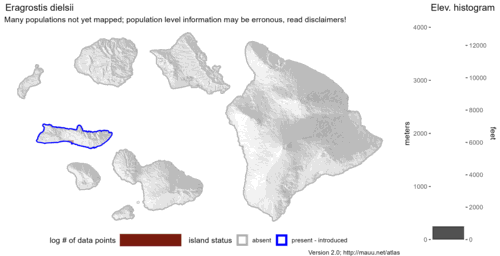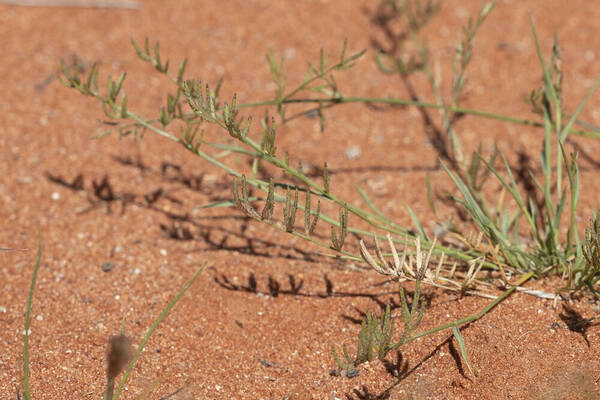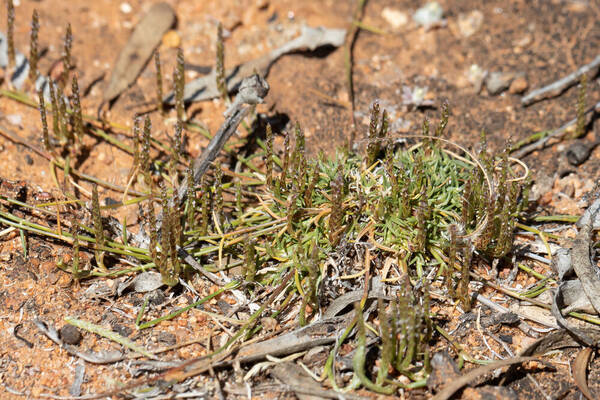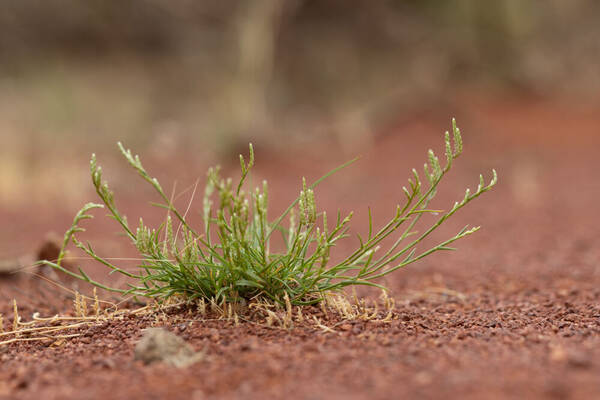Info
Subfamily: Chloridoideae
Genus etymology: Eragrostis = "love grass" [Greek] unclear origin, other etymologies such as "early grass" or "very grass" have also been speculated
Species etymology: dielsii = Honorific for Friedrich Ludwig Emil Diels (1874–1945)
Photosynthetic type: C4 (warm season)
Nativity: naturalized - accidental
First recorded in Hawaiʻi: 2008
Map

Inflorescence
 image credit: Kym_Nicolson
image credit: Kym_Nicolson image credit: Kym_Nicolson
image credit: Kym_NicolsonPlant
 image credit: Kym_Nicolson
image credit: Kym_NicolsonSpikelets
 image credit: Kym_Nicolson
image credit: Kym_NicolsonDescription
Habit: Perennial; short-lived; caespitose. Culms erect, or geniculately ascending; 7-30 cm long. Ligule a fringe of hairs. Leaf-blades 4-8 cm long; 1-2 mm wide. Leaf-blade surface scabrous. Inflorescences: Inflorescence a panicle. Panicle open, or contracted; linear, or lanceolate, or elliptic; equilateral, or secund; 2-10 cm long; 1-1.5 cm wide; gathered into fascicles. Primary panicle branches distant; 1 -nate; indistinct the panicle almost racemose, or simple; 0-3 cm long. Spikelets solitary. Fertile spikelets sessile. Spikelets: Spikelets comprising 9-81 fertile florets; with diminished florets at the apex. Spikelets linear; straight, or curved; laterally compressed, or subterete; compressed slightly; 15-25 mm long; 1-1.5 mm wide; breaking up at maturity; rhachilla persistent; retaining paleas. Fertile Spikelets: Spikelets comprising 9-81 fertile florets; with diminished florets at the apex. Spikelets linear; straight, or curved; laterally compressed, or subterete; compressed slightly; 15-25 mm long; 1-1.5 mm wide; breaking up at maturity; rhachilla persistent; retaining paleas. Glumes: Glumes deciduous; similar; shorter than spikelet. Lower glume oblong; 1.5 mm long; 1 length of upper glume; membranous; 1-keeled; 1 -veined. Lower glume lateral veins absent. Lower glume apex acute. Upper glume oblong; 1.5 mm long; 0.66-0.75 length of adjacent fertile lemma; membranous; 1-keeled; 1 -veined. Upper glume lateral veins absent. Upper glume apex acute. Florets: Fertile lemma ovate; 2-2.5 mm long; membranous; keeled; 3 -veined. Lemma lateral veins prominent; midway between midvein and margin. Lemma apex obtuse. Palea keels ciliolate. Apical sterile florets resembling fertile though underdeveloped. Flowers: Lodicules 2; cuneate; fleshy. Fruits: Caryopsis with adherent pericarp; ellipsoid; dorsally compressed. Distribution: Australasia: Australia. Pacific: north-central.
(Description source: Clayton, W.D., Vorontsova, M.S., Harman, K.T. and Williamson, H. (2006 onwards). GrassBase - The Online World Grass Flora. Available at https://powo.science.kew.org )